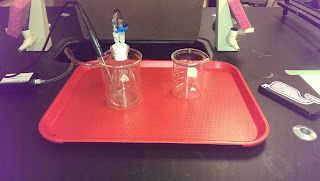Blowing Up Luke Luke was placed on top of a black blowup bag. Four students stuck straws into the holes of the bag and blew air particles in. At first, the bag inflated and surrounded Luke. There were few air particles that moved slowly at this stage. As more air particles were blown in, the bag inflated all the way and slowly lifted Luke from the table. At this stage, there were many more air particles which moved faster than before, resulting in a fully inflated bag. Afterwards, we created a storyboard of the particles in the blowup bag in 4 different stages.
 |
| storyboard of Luke being blown up |
 |
| pressure sensor for this experiment and the next one |
Pressure Vs. Temperature In the experiment, we found out how pressure and temperature related. The first thing we did was attach the temperature and pressure sensors to the LabQuest interface. We then set up the graph and table. Then we had to securely put the stopper in the flask. However, we forgot to complete this step so our data was incorrect. We then placed the flask in a 600 mL beaker. Then we found the pressure and temperature of room temperature. Then we recorded the pressure and temperature of hot water, warm water, ice water, and alcohol/ice bath. Afterwards, we added a line of best fit, which was a directly proportional graph. Our prediction was also a directly proportional graph. We concluded that the higher the temperature, the larger the pressure. Since we messed up on our experiment, I used table 1's graph as a replacement.
 |
| temperature and pressure sensors for this experiment |
 |
| Alcohol/ice bath - Lauren |
 |
| altered graph for pressure vs. volume |
 |
| altered graph for pressure vs. puffs |
 |
| altered graph for pressure vs. temperature |
No comments:
Post a Comment